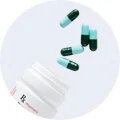The core responsibility of active pharmaceutical ingredient manufacturers is to produce safe, effective, stable, and high-quality active pharmaceutical ingredients that meet global regulatory standards. These ingredients are the "therapeutic core" of pharmaceuticals, so manufacturers’ responsibilities span the entire product lifecycle, from R&D and production to quality control, supply chain management, and post-marketing supervision. Below is a detailed breakdown of their main responsibilities:
1. R&D and Process Development: Lay the Foundation for Quality APIs
Before formal production, active pharmaceutical ingredient manufacturers must complete rigorous research and process design to ensure the scalability of API synthesis. Key tasks include:
Route Design & Optimization: Develop or optimize chemical synthesis routes (for small-molecule APIs) or bioprocesses (for biological APIs, e.g., monoclonal antibodies) to minimize impurities, reduce production costs, and improve yield. For example, avoiding toxic intermediates or simplifying reaction steps to lower safety risks.
Process Validation: Verify that the designed production process is stable, reproducible, and controllable under commercial-scale conditions. This includes testing critical process parameters (e.g., temperature, reaction time, pH) to ensure consistent API quality across batches.
Preclinical/Clinical Support: Provide high-purity APIs (e.g., GMP-grade clinical APIs) for pharmaceutical companies’ preclinical studies (e.g., toxicity tests) and clinical trials (Phase I/II/III), ensuring compliance with regulatory requirements for trial materials (e.g., FDA’s IND, EMA’s IMPD).
2. GMP-Compliant Production: Ensure Consistency and Safety
Production is the core link of API manufacturing, and compliance with Good Manufacturing Practice (GMP) is mandatory globally (e.g., FDA cGMP, EMA GMP, China NMPA GMP). Specific responsibilities include:
Facility & Equipment Management: Maintain production facilities (e.g., cleanrooms, reactors, purification systems) that meet GMP standards—regularly clean, sanitize, and calibrate equipment to prevent cross-contamination (e.g., between different APIs) and ensure accurate operation.
Raw Material Control: Strictly screen and inspect raw materials (e.g., chemical intermediates, biological substrates) to ensure they meet quality standards (e.g., USP, EP, BP). Only qualified raw materials can enter the production process to avoid "source-related" quality risks.
Batch Production & Documentation: Execute production processes in strict accordance with validated procedures, and maintain complete, real-time, and traceable batch records (e.g., raw material usage, process parameters, sampling results). These records are critical for regulatory audits and batch recall investigations.
Contamination Prevention: Implement measures to prevent physical (e.g., dust), chemical (e.g., solvent residues), and biological (e.g., microorganisms) contamination. For example, using closed production systems for highly potent APIs (HPAPIs) or sterile APIs.
3. Strict Quality Control (QC): Eliminate Defective Products
API quality directly determines the safety and efficacy of finished drugs. Manufacturers must establish a comprehensive QC system to test every link:
In-Process Testing (IPT): Sample and test APIs during production (e.g., after synthesis, purification) to monitor key quality indicators (e.g., purity, content, particle size). If parameters deviate, production is paused to adjust, preventing defective products from entering the next step.
Finished API Testing: Conduct full-item testing on the final API batch in a GMP-certified laboratory, covering:
Identity: Confirm the API is the correct chemical/biological entity (e.g., via HPLC, mass spectrometry).
Purity & Impurities: Control organic impurities (e.g., by-products), inorganic impurities (e.g., heavy metals), and residual solvents (e.g., ethanol, dichloromethane) within regulatory limits (e.g., ICH Q3A/Q3C guidelines).
Stability: Test API stability under different conditions (e.g., high temperature, humidity, light) to determine its shelf life and storage requirements (e.g., "store at 2-8°C").
Quality Release: Only APIs that pass all QC tests and meet regulatory standards (e.g., USP monographs) are approved for release to customers (pharmaceutical formulation companies).
4. Regulatory Compliance: Meet Global Standards
active pharmaceutical ingredient manufacturers must adhere to the regulatory requirements of the markets they serve (e.g., the U.S., EU, China, Japan) to ensure their products are legally marketable. Key responsibilities include:
Regulatory Filings: Prepare and submit technical documents to regulatory authorities, such as:
DMF (Drug Master File): A confidential file submitted to the FDA/EMA that details API manufacturing processes, quality control, and facilities (used by pharmaceutical companies when filing NDAs/ANDAs for finished drugs).
CEP (Certificate of Suitability): Issued by the EDQM (European Directorate for the Quality of Medicines) to confirm that an API meets the quality requirements of the European Pharmacopoeia (EP).
Regulatory Audits: Cooperate with inspections by global regulatory agencies (e.g., FDA, EMA, NMPA). For example, if a manufacturer supplies APIs to the U.S., it must pass FDA cGMP audits to avoid import bans.
Post-Marketing Compliance: Update regulatory documents in a timely manner (e.g., if production processes are optimized) and report any quality issues (e.g., impurity exceedances) to authorities as required.
5. Supply Chain & Logistics Management: Ensure Timely and Safe Delivery
APIs are global commodities, so manufacturers must manage the supply chain to balance stability, safety, and efficiency:
Supply Chain Traceability: Track the entire chain from raw material suppliers to API delivery, ensuring that every link is traceable (critical for recalling defective batches).
Logistics Compliance: Choose appropriate transportation methods based on API properties (e.g., refrigerated trucks for temperature-sensitive biological APIs, sealed containers for toxic APIs) to maintain quality during transit.
Risk Mitigation: Establish backup suppliers for key raw materials or multi-site production capabilities to avoid supply disruptions (e.g., due to natural disasters, geopolitical issues).
6. Post-Marketing Surveillance & Adverse Event Management
Even after APIs are marketed, manufacturers remain responsible for monitoring their long-term safety and quality:
Batch Feedback Tracking: Collect feedback from customers (pharmaceutical companies) on API quality in finished drugs (e.g., dissolution issues) and investigate the root cause (e.g., process deviations, storage errors).
Adverse Event Reporting: If finished drugs cause adverse reactions (e.g., allergies) and the root cause is traced to the API (e.g., impurity-related), manufacturers must report this to regulatory authorities and take corrective actions (e.g., recalling batches, optimizing processes).
Continuous Improvement: Analyze post-marketing data to optimize production processes, update quality standards, or enhance GMP compliance (e.g., adopting new detection technologies to reduce impurity levels).
Summary
In essence, active pharmaceutical ingredient manufacturers are the "gatekeepers" of pharmaceutical safety. Their responsibilities revolve around a core goal: producing APIs that meet global quality and regulatory standards to ensure the safety, efficacy, and stability of the finished drugs that ultimately reach patients. Any failure in these links (e.g., GMP violations, impurity control errors) could lead to severe consequences, such as drug recalls, regulatory penalties, or even harm to public health.
The core responsibility of active pharmaceutical ingredient manufacturers







